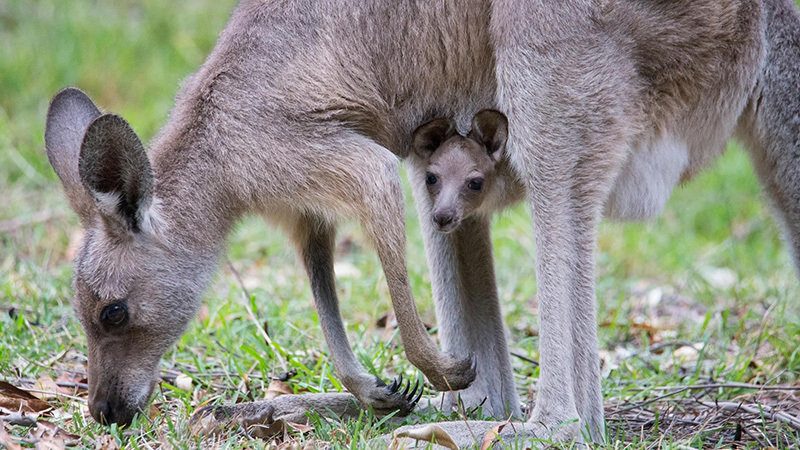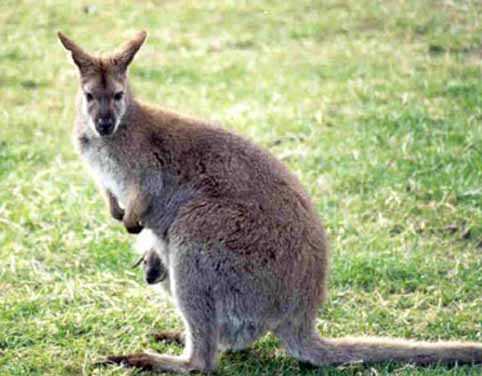

A kangaroo is a marsupial from the family Macropodidae (macropods, meaning 'large foot'). In common use the term is used to describe the largest species from this family, especially those of the genus Macropus, Red Kangaroo, Antilopine Kangaroo, Eastern Grey Kangaroo and Western Grey Kangaroo. Kangaroos are endemic to the continent of Australia. The smaller macropods are found in Australia and New Guinea.
Larger kangaroos have adapted much better to changes brought to the Australian landscape by humans and though many of their smaller cousins are endangered, they are plentiful. They are not farmed to any extent, but wild kangaroos are shot for meat, leather hides, sport, and to protect grazing land for sheep and cattle.
Although there is some controversy, harvesting kangaroo meat has many environmental and health benefits over sheep or cows grazed for meat.
The kangaroo is a national symbol of Australia: its emblem is used on the Australian coat of arms, on some of its currency, as well as by some of Australia's best known organizations, including Qantas. The kangaroo is important to both Australian culture and the national image and consequently there are numerous popular culture references.
The word kangaroo derives from the Guugu Yimidhirr word gangurru, referring to a grey kangaroo. The name was first recorded as "Kangooroo or Kanguru" on 4 August 1770, by Lieutenant (later Captain) James Cook on the banks of the Endeavour River at the site of modern Cooktown, when HM Bark Endeavour was beached for almost seven weeks to repair damage sustained on the Great Barrier Reef. Guugu Yimidhirr is the language of the people of the area.
A common myth about the kangaroo's English name is that 'kangaroo' was a Guugu Yimidhirr phrase for "I don't understand you." According to this legend, Lieutenant Cook and naturalist Sir Joseph Banks were exploring the area when they happened upon the animal. They asked a nearby local what the creatures were called. The local responded "Kangaroo", meaning "I don't understand you", which Cook took to be the name of the creature. The Kangaroo myth was debunked in the 1970s by linguist John B. Haviland in his research with the Guugu Yimidhirr people.
Male kangaroos are called bucks, boomers, jacks, or old men; females are does, flyers, or jills, and the young ones are joeys. The collective noun for kangaroos is a mob, troop, or court. Kangaroos are often colloquially referred to as roos.
There are four species that are commonly referred to as kangaroos:
The Red Kangaroo (Macropus rufus) is the largest surviving marsupial anywhere in the world. Fewer in numbers, the Red Kangaroo occupies the arid and semi-arid centre of the continent. A large male can be 2 metres (6 ft 7 in) tall and weigh 90 kg (200 lb).
The Eastern Grey Kangaroo (Macropus giganteus) is less well-known than the red (outside of Australia), but the most often seen, as its range covers the fertile eastern part of the continent.
The Western Grey Kangaroo (Macropus fuliginosus) is slightly smaller again at about 54 kg (119 lb) for a large male. It is found in the southern part of Western Australia, South Australia near the coast, and the Darling River basin.
The Antilopine Kangaroo (Macropus antilopinus) is, essentially, the far-northern equivalent of the Eastern and Western Grey Kangaroos. Like them, it is a creature of the grassy plains and woodlands, and gregarious. In addition, there are about 50 smaller macropods closely related to the kangaroo in the family Macropodidae.
Europeans have long regarded kangaroos as strange animals. Early explorers described them as creatures that had heads like deer (without antlers), stood upright like men, and hopped like frogs. Combined with the two-headed appearance of a mother kangaroo, this led many back home to dismiss them as travelers' tales for quite some time.
The first kangaroo to be exhibited in the western world was an example shot by John Gore, an officer on Captain Cook's Endeavour in 1770. The animal was shot and its skin and skull transported back to England whereupon it was stuffed (by taxidermists who had never seen the animal before) and displayed to the general public as a curiosity.
Kangaroos have large, powerful hind legs, large feet adapted for leaping, a long muscular tail for balance, and a small head. Like all marsupials, female kangaroos have a pouch called a marsupium in which joeys complete postnatal development.
Kangaroos are the only large animals to use hopping as a means of locomotion. The comfortable hopping speed for Red Kangaroo is about 20-25km/h (13Ð16 mph), but speeds of up to 70 km/h (44 mph) can be attained, over short distances, while it can sustain a speed of 40 km/h (25 mph) for nearly two kilometres. This fast and energy-efficient method of travel has evolved because of the need to regularly cover large distances in search of food and water, rather than the need to escape predators.
Because of its long feet, it cannot walk correctly. To move at slow speeds, it uses its tail to form a tripod with its two forelimbs. It then raises its hind feet forward, in a form of locomotion called "crawl-walking."
The average life expectancy of a kangaroo is about 4-6 years. Read more ...
Female kangaroos have two vaginas - or three, if they've given birth. How could that be? Live Science - April 5, 2025

The most likely explanation is that it's an adaptation to Australia's unforgiving environment. Multiple vaginas - and uteruses, of which they also have two - enable female kangaroos, and all marsupials, to have multiple offspring at different stages of development at any given time. That helps increase the chances of one surviving to adulthood.
Kangaroos Didn't Always Hop, Scientists Say Science Alert - June 20, 2023
Scientists say that not so long ago (evolutionarily speaking, anyway), extinct large kangaroos likely used other modes of transportation, like walking on two legs or all fours.
Giant Kangaroo From 50,000 Years Ago Isn't Even Related to Australian Ones Science Alert - June 29, 2022
Long ago, almost up until the end of the last ice age, a peculiar giant kangaroo roamed the mountainous rainforests of New Guinea. Now, research published by myself and colleagues suggests this kangaroo was not closely related to modern Australian kangaroos. Rather, it represents a previously unknown type of primitive kangaroo unique to New Guinea.

A wallaby is any of about thirty species of macropod (Family Macropodidae). It is an informal designation generally used for any macropod that is smaller than a kangaroo or wallaroo that has not been given some other name.
Very small forest-dwelling wallabies are known as pademelons (genus Thylogale) and dorcopsises (genera Dorcopsis and Dorcopsulus). The name wallaby comes from the Eora Aboriginal tribe who were the original inhabitants of the Sydney area. Young wallabies are known as "joeys", like many other marsupials.
Wallabies are widely distributed across Australia, particularly in more remote, heavily timbered, or rugged areas, less so on the great semi-arid plains that are better suited to the larger, leaner, and more fleet-footed kangaroos. They were introduced in New Zealand, where they are seen as a pest and are often hunted. There are also a few populations of wallabies in the British Isles, the largest of which can be found on the Isle of Man where there is a breeding colony of around 100. Wallaby Wikipedia
ANCIENT AND LOST CIVILIZATIONS